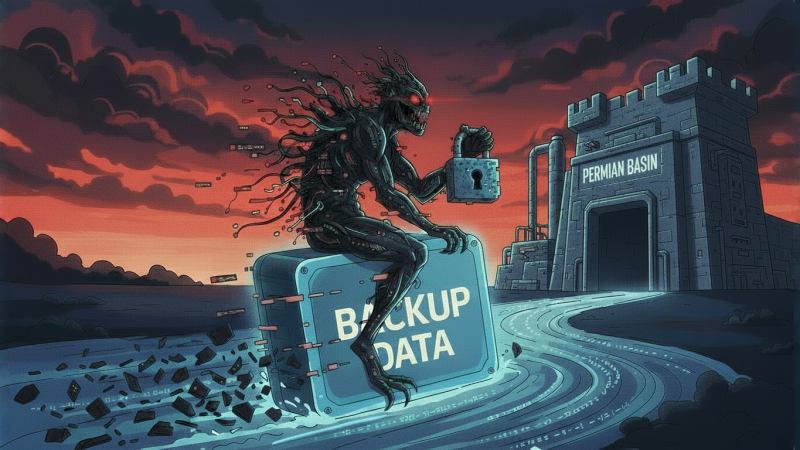Your backup isn’t IT housekeeping. It’s the foundation of your cybersecurity. And in the Permian Basin, where every business connects to America’s energy infrastructure, you’re already a target.
Look, we see this a lot. Companies with solid IT practices, regular backups and decent security tools are still getting hit for millions in ransom. Why? Because they treated backup like a storage problem instead of a security foundation.
Every business in the Basin connects to a supply chain producing over 6 million barrels of oil daily. That’s nearly half of America’s total production. That accounting firm processing drilling payroll down the street. The equipment supplier in Crane. The safety consultant in Odessa.
Cybercriminals see you as stepping stones. They don’t need to hack Chevron directly when they can compromise the vendor who has access to Chevron’s network. That vendor could be you.
Not trying to scare you. Just telling you what we see out here.
Tuesday morning, 10 a.m., someone in the office clicks that phishing link—the one that looks exactly like a legitimate invoice from your pipe supplier. Nothing happens. Computer runs fine. No warnings.
But that ransomware? It’s already crawling through your network. Not encrypting anything yet, just spreading for the next 8-10 hours, attaching itself to everything. Your permits, drilling reports, that massive vendor spreadsheet. It doesn’t execute yet. It just waits.
Midnight. Your backup system kicks in, doing exactly what it’s supposed to do – backing up everything including the ransomware that’s now buried in your files. The ransomware rides your backup, getting copied right onto your backup servers with your legitimate data.
3 a.m., the office is empty except maybe your night shift checking wells. That’s when it strikes. It encrypts your production files AND attacks your backup servers simultaneously. The ransomware that rode into your backup environment executes from within, corrupting your restore points from the inside.
No clean backups? You’re writing that ransom check.
Most IT backup follows the 3-2-1-1-0 rule: 3 copies, 2 media types, 1 offsite, 1 immutable, 0 failures. Your IT team checks that box and moves on.
Here’s the missing security problem: Only ONE copy is immutable and a single point of failure.
So when ransomware rides your backup into those non-immutable copies, it can execute and encrypt them from within. You’ve basically invited the attacker into your recovery environment. And if that one immutable copy fails, gets corrupted, or isn’t recent enough?, you’re stuck with infected backups. Useless.
This is the difference between IT backup (meeting minimum requirements) and security-grade backup (actually protecting against modern threats).
Don’t think IT backup, think security backup. That’s how we approach it at Guardian. Don’t count on just the minimum. Consider an approach like our 3-2-2-1-0 standard.
– 3 copies (redundancy)
– 2 media types (diversity)
– 2 locations – one local in the Basin for speed, one outside ERCOT for grid resilience
– 1 immutable standard—applied to EVERY copy, not just one
– 0 failures
Here’s the reason all-immutable matters. Even if ransomware rides into your backup during the backup process, it can’t execute against immutable storage. It can’t encrypt what can’t be modified. The ransomware might be there, but it’s powerless. It’s like a virus in a sealed jar.
Every copy. Every location. All immutable.
Everyone’s trying to sell you complex cybersecurity platforms. MDR, SIEM, XDR, endpoint detection. The acronyms alone make your head spin, right?
But here’s what security professionals know: Data protection is the foundation of cybersecurity. Not the exciting part. Not the AI-powered part. Just the part that makes everything else possible.
Think about it. Your firewall? Ransomware got past it. That antivirus you bought didn’t catch the zero-day. Someone clicked the link despite all that training. But those immutable backups—that’s the foundation that lets you rebuild.
Without a solid foundation, all that advanced security tech is just decoration on a house of cards. Get the foundation right first. Then layer on the sophisticated tools. That’s the right order.
With security-grade backup (3x daily, all immutable, geographically distributed), ransomware can’t corrupt your backups. Period. Even if it infiltrates your production environment.
Maximum data loss? 8 hours. Not weeks, not months, not your entire business. And definitely not a multi-million-dollar ransom payment like companies recently had to pay.
Plus, we’re local in the Basin. Your recovery is fast. You’re not waiting for data to download from Virginia while your rigs sit idle. Your data is here, protected, ready when you need it.
That’s the difference between treating backup as IT overhead versus treating it as security infrastructure.
Look, this isn’t about buying our solution. It’s about understanding your real security position. Ask yourself:
1) Your current backup: Is it truly immutable? All copies or just one?
2) Last restore test: When did you actually verify you can recover? Last month? Last year?
3) Your exposure: How many hours of data loss puts you out of business?
4) Ransomware defenses: Can ransomware ride your backup?
5) Geographic distribution: Single point of failure if the Texas grid goes down?
At Guardian, we built our solution because Basin businesses deserve security-grade protection, not just IT checkboxes. Every copy immutable. Local presence for fast recovery. Geographic distribution for resilience.
This isn’t IT backup with security features bolted on. This is backup designed as security infrastructure from day one. Because when you’re part of America’s energy infrastructure, standard IT backup isn’t enough. Not even close.
Guardian’s Basin Backup uses the 3-2-2-1-0 security framework with all immutable copies, local Basin presence for fast recovery, and geographic distribution outside ERCOT. Because in the Basin, we don’t just meet the standard—we exceed it.
Want to know where you stand? Take this short Basin Ransomware Readiness Assessment.
